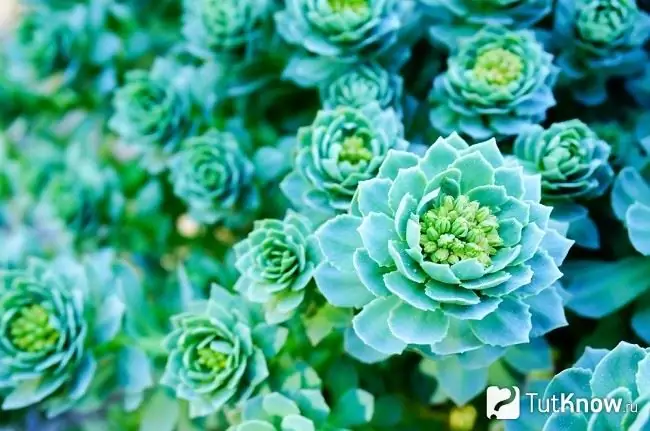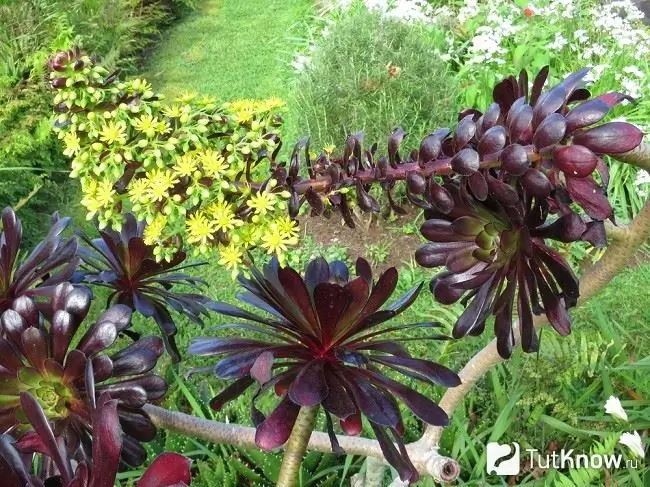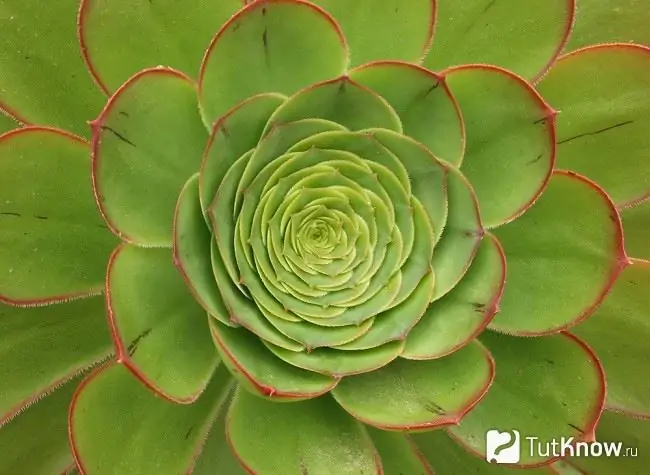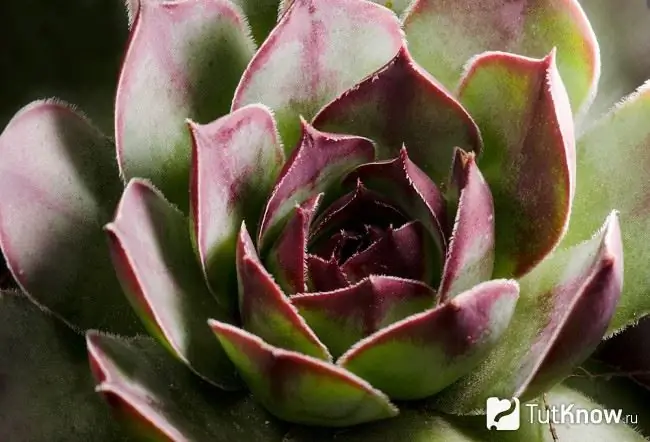- Author Arianna Cook [email protected].
- Public 2024-01-12 17:55.
- Last modified 2025-06-01 07:38.
Description of aeonium, its varieties, as well as an overview of recommendations for care and reproduction at home by amateur flower growers. Eonium is part of the large Tolstyankov family. In Latin, the name of the plant sounds like Aeonium, and it is ranked among the Crassulaceae - herbaceous and shrub-like succulents that are widespread in East Africa, the shores of the Mediterranean Sea and the Canary Islands. This most famous representative of the Tolstyankovs got its name over a long period of life, since his name is derived from aionois (other Greek) - long-liver.
Description of the plant indoor aeonium

All varieties of the succulent in question have a succulent thick stem and the same leaves. The shape of the latter can be finely toothed or whole-edged, but in each case it tapers towards the base and demonstrates the presence of white cilia along the edge. Leaves are usually smooth, only some species of aeonium have a dense fluff. They are formed at the end of stems and branches, creating a dense rosette of the most diverse shapes, the size of which can reach 1 meter in diameter.
During the flowering period, a peduncle shoot is pulled out, on which brushes appear in the form of a pyramid, made up of small flowers of a yellow, white or pink hue. It is extremely difficult to achieve flowering of aeonium under conditions of home cultivation, but if it works out, then it will last quite a long time, and as soon as it ends, the peduncle will die and disappear. Individual varieties, in which the stem does not branch and therefore forms a rosette only in the singular, completely die immediately after flowering.
Types of aeonium

- Noble (in lat. Aeonium nobile) is a succulent plant with a shortened stem and wide fleshy leaves with curved edges and a delicate olive shade. The size of the rosettes reaches an average of 50 cm in diameter, the height of the peduncle is 40-50 cm, and the flowers form beautiful copper-colored umbrellas that retain their decorative appearance for 1-1.5 months.
- Burchard's view (in lat. Aeonium burchardii) is a perennial succulent with a brown shiny stem. The leaves are collected in compact rosettes with a diameter of 9-10 cm and are colored dark green, orange or yellow.
- Virginian (in lat. Aeonium virgineum) is called a type of aeonium, which has no stem at all. The plant forms a large number of rosettes of bright green leaves, forming groups and creating formations that resemble pillows. In the natural environment, the Virginia aeonium grows strongly and its rosettes reach 1 m in height. In the summer, the plant is decorated with beautiful lemon-colored flowers.
- Wavy (in lat. Aeonium undulatum) aeonium belongs to perennial succulents, distinguished by a powerful stem, from which practically no branches depart at all. In the upper part there are rosettes with a diameter of about 30 cm, consisting of wide shovel-like leaves with a glossy dark green surface. The decoration of the plant is large flowers of a rich yellow hue, united in pyramidal inflorescences.
- Decorative (in lat. Aeonium decorum) - a kind of perennial intensively branching loose shrub, stretching upwards for half a meter. Its stems are rough, and diamond-shaped traces remain in the places where old leaves are formed. Leathery leaves have an even smooth surface and pinkish color, their length is up to 3 cm, and their width is up to 1.5 cm. Inflorescences are formed on long (up to 45 cm) peduncles of a light pink shade. The color of the flowers themselves is pale pink.
- Domestic (Aeonium domesticum) - perennial shrub with a height of up to 20-30 cm. It begins to branch from the base, at first bending strongly to the side, but then stretching vertically upward. The leaves differ from other varieties of aeonium by the presence of glandular hairs, their size is 1 cm wide and 2 cm long. Beautiful yellow flowers are located on one inflorescence, which stretches 15-20 cm.
- Woody (Aeonium arboreum) - a semi-shrub form of a perennial succulent with a woody stem, which practically does not branch and is located strictly vertically. On the spatulate leaves of a light green hue, gathering in dense rosettes with a diameter of 20 cm, you can see white cilia. In the natural environment, the species of arboreal aeonium forms a tall (30-35 cm) inflorescence, consisting of spectacular golden-yellow flowers with small stars.
- Canary (Aeonium canariensis) is a perennial herbaceous species with a short stem. During the first 2 years of their life, the leaves form a rosette close to the ground, and it consists of wide spatulate leaves covered with a short gray downy. The inflorescence of the Canary Aeonium is quite large and is up to 80-85 cm in height with a rosette diameter of 50x50 cm.
- Golden (Aeonium holochrysum) - a beautiful succulent with an unusual shape of stems, which at first grow erect, and then branch out and take a drooping, drooping shape. The leaves are not wide and resemble a spatula in shape, but they are thick and have a golden hue of the background, a red stripe in the middle and scarlet edges. They are collected in rosettes up to 20 cm in diameter, on which golden flowers appear.
- Lindley's variety (Aeonium lindleyi) - a very branched perennial and evergreen shrub plant about 20-30 cm in height. The rosettes are distinguished by the density of the small leaves that form them with a small fluff and a sticky, pleasant smelling surface. On drooping brushes, beautiful flowers with a yellowish-golden tint are formed.
- Layered (Aeonium tabulaeforme) - undersized type of succulent with almost absent or very short stem. At its top, a very dense flat rosette is formed, resembling a plate. Its diameter is about 0.5-0.6 m. The leaves have a very narrow base and widen strongly towards the middle, and are decorated with pale gray cilia along the edges. The rosette is made up of leaves that are adjacent to each other, like a roof is laid out from tiles. Yellow flowers gather in a loose inflorescence, in the form of a wide pyramid. After the flowering period is over, the layered aeonium forms capsules with seeds and dies.
- Variety Haworth (in lat. Aeonium haworthii) is a branched shrub, the height of which does not exceed 30 cm. Its distinctive feature is the aerial root system, which is created by lateral branches appearing directly under the rosettes of grayish-green leaves. Their size: up to 3 cm wide and up to 2.5 cm long. Light yellow flowers with a pinkish tint are formed on drooping inflorescences, reaching, in turn, 20-30 cm.
Recommendations for the care of aeonium in indoor conditions

- Lighting. All types of aeonium require intense lighting. This also applies to the period of active development of the plant and its "rest" time. With a lack of light, the leaves will be the first to suffer, the shade of which will become faded and expressionless. Then the stems will react, which can become very thin, and the rosettes that lose their beautiful dense shape. In this regard, flowerpots should be placed on windows facing the south or southeast side. But at the same time, it is important to take into account that the aeonium very badly tolerates the midday summer heat, and therefore, it must be shaded, avoiding direct sunlight in the summer months. The rest of the time, leaving the plant in the sun is not only possible, but also necessary, otherwise the chances that it will bloom will greatly decrease. Thus, from October to March in our latitudes, you can leave the bush in the sun all day, but starting in May it is shaded, providing diffused light that will allow it to develop normally. In addition, it must be borne in mind that the side facing the light source will grow more intensively, therefore, in order for the eonium to form a beautiful round shape, it must be turned once a week, shifting it by 1/4 of a turn.
- Temperature. In winter, the temperature for resting is 11-12 degrees Celsius. But at the same time, the aeoniums, without any special negative consequences, experience the climatic regime usual for living rooms. For the other three seasons, the plant is comfortable at 20-25 degrees, at which intensive vegetative development is observed. In the summer, it is better to expose flowerpots to fresh air, as a result of which the shade of their leaves and flowers will become deeper and more saturated. It is very important not to place the aeoniums close to heating sources in the winter months, since the increased temperature of the content during the dormant period will lead to an increase in the distance between the nodes. Due to such stretching, the plant will lose its beautiful decorative appearance. If in the summer the air temperature will exceed 30 degrees for a long time, then the aeonium is able to fall into stagnation, stopping its development. In order to bring him out of this state of summer dormancy, it is enough to simply move the flowerpot to a cooler place.
- Air humidity. It is not required to specially spray the plant or humidify the air around it, since the eonium quietly develops without any harm to itself in the usual dry climate of residential apartments and houses. If there is a desire to improve its conditions, then you can periodically expose the plant to fresh air and intensively ventilate the room where it grows, and also occasionally wipe the leaves with a damp cloth, removing dust deposits.
- Watering. Special attention to watering is not required, the main thing is that the soil does not dry out too much. This rule also applies to the flowering period, since the aeonium does not need a lot of moisture. It is quite enough to add it in small quantities 2-3 days after the surface is dry. In winter, this should be done even less often, controlling only so that the soil does not dry out excessively. Usually, for this, the state of the leaves is monitored, adding water at the moment when they begin to wrinkle. Top watering is chosen as the method of adding moisture, while the bottom is categorically contraindicated. If, after watering, water accumulates in the plate under the pot, then it should be eliminated, not allowing it to stagnate there. In addition, it is necessary to control the places of water ingress so that it does not accumulate in the axils of the leaves and at the base of the stems, otherwise comfortable conditions for the development of fungal infections may form. There is an effective method for determining the need for watering. It is required to press on the eonium leaf at the point of growth. If the fingers feel elastic, then you can not rush to water, but when the leaf is sluggish to the touch, you need to moisten the soil.
- Fertilizer. In the spring and summer, when the aeoniums enter the stage of active growth and flowering, it is enough to feed them 1 time in 2 weeks. For these purposes, fertilizers are used ready-made and sold in stores for cacti (succulents). In winter, during dormancy, the plants do not need additional nutrients, so feeding at this time is completely stopped.
- The soil. If there is a desire, then for planting aeonium, you can prepare a soil of such a composition. Peat, sand, leafy and soddy soil are taken in equal parts. Otherwise, you can go the easier way simply by purchasing specially prepared cactus soil, which is sold in any flower shop. To improve it a little, you can dilute its composition with crushed charcoal.
- Transfer. Young plants of aeonium should be replanted every year, and after the onset of the maturation phase (4-5 years), this procedure is repeated after about 3 years. During the transplant, there are no specific moments. The main thing is to remember that the roots are very afraid of excess moisture, so a good drainage layer must be provided in the new pot. For its formation, you can simply pour expanded clay on the bottom.
Reproduction of aeonium

As mentioned above, aeonium is propagated vegetatively or by seeds.
Vegetative propagation occurs through cutting and planting cuttings. It is usually carried out from April to July. In order to facilitate this procedure, cuttings should be prepared before the aeonium enters the flowering phase, otherwise the material obtained for propagation will not root well. As a result, this will cause a lot of trouble and may not give the desired result at all.
Rooting conditions for cuttings:
- For planting, use the same soil composition as for adult cacti.
- The lighting should not be direct, but diffused sunlight is best.
- The required temperature range is 20-25 degrees Celsius.
- Watering is moderate, water is added after the earthen lump dries up a little.
- The approximate period of aeonium rooting is 12-15 days.
As for reproduction by seeds, the seeds obtained after ripening retain their germination for another 4-5 years. In order to ensure such a long shelf life, they should be placed in the refrigerator, but never in the freezer. Planting seeds of aeonium is usually carried out towards the end of the summer period. To do this, prepare an earthen mixture of the following composition:
- perlite 1 part;
- charcoal 1 part;
- leaf humus 2 parts.
When planting, the seeds are simply placed on wet soil, it is not required to sprinkle them with earth, but you will need to cover them with a film.
For the seeds of aeonium to sprout, you will need:
- maintain air humidity at 100%;
- do not allow the substrate to dry out;
- set the temperature regime within 18-20 degrees;
- provide a sufficient level of diffused lighting.
Usually, there are no problems with germination of aeonium seeds. If they categorically do not want to grow, then, most likely, the air temperature exceeds the recommended values, and therefore the seeds have fallen into a state of stagnation and do not want to develop.
The first picking of sprouts is carried out 10-11 days after they have appeared. This procedure is repeated after the leaves have closed. If the seeds were located close to each other during planting, and the grower did not make a pick in time, then some seedlings will begin to oppress others, preventing them from developing normally.
Aeonium pests

The main enemy of the aeonium is the mealybug. This parasite usually settles between individual leaves in the outlet and begins to actively feed, as a result of which the decorative appearance of the plant is quickly lost. The first measure to combat this pest will be wiping the leaves and stems with a damp sponge, which is moistened with medical alcohol or soapy water.
If the pests have actively spread, then systemic chemical preparations can be used, among which are very effective: Confidor, Aktara, Karbofos or Actellik.
The main difficulties in growing indoor aeonium

- Small leaves and bare stems are usually the result of inadequate watering.
- Stem elongation and thinning occurs, as a rule, due to insufficient light levels.
- Looseness of the rosette, asymmetrical growth of leaves appear from a lack of sunlight. It is necessary to correct this moment and periodically rotate the flowerpot so that individual parts of the aeonium have enough light and heat.
- Reddening of the leaves in most cases occurs due to high solar radiation, so it is required to shade the plant.
- Darkening and death of leaves is usually the result of over-watering.
How to propagate aeonium, you will learn from this video:






